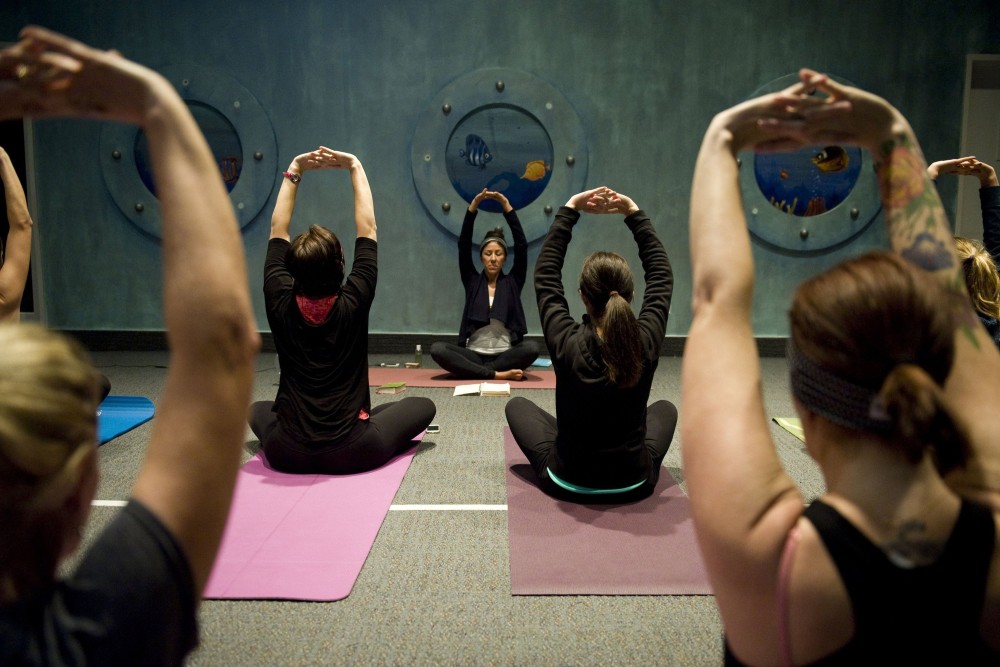By Shoba Narayan
Mint, New Delhi.
In an ideal world, stilettos would have massager-inserts in them; French fries would remove the toxins from your body and make your waistline shrink; and everyone would have the willpower to do whatever they wanted to accomplish.
But reality, sadly, is a little different. Social psychology points to four characteristics that lead to success — resilience, willpower, focus and imagination.
In an outlandish and somewhat brilliant twist, all four of these characteristics can be cultivated by a practice that is at least as ancient as Indian corruption. I speak, of course, of the global juggernaut that we call yoga.
As someone who learnt yoga as a child, I am a little unnerved by the sight of blonde women with long Scandinavian bodies chanting Sanskrit mantras and doing the downward dog with far more flexibility than I ever could.
I suppose I should feel proud rather than resentful. After all, it takes a special kind of inventiveness to look at how scorpions, dogs, crows and locusts move and come up with asanas that manage to enlighten or humiliate, depending on what level you’re at.
Like many Indian children, I was sent off to the local playground to learn yoga from a man who looked like a military commander.
My teacher made us contort our bodies into bends, stretches and lunges. No theory was given. Raps on the knuckles were a favoured mode of punishment, along with “Stand up on the bench”, except that there was no bench on the field, so it was modified to “Stand up on the branch”, which was equally humiliating because we stood there swaying on a guava branch that was permanently at risk of breaking.
I have remained interested in yoga. I do the asanas or poses every now and then, sometimes consistently and sometimes sporadically.
Looking back, it seems like I turned to yoga at transition points in my life. As a newly wed, my husband would walk into the house and find me engaged in a headstand — an unnerving experience for him, particularly after a flaming row. When things got rough in graduate school, I would find myself waking up in the morning and doing the Trikonasana, or the triangle pose, bending down as if I was surrendering to a higher power — or in my case, my thesis adviser.
After the birth of my children, my gynecologist recommended stretches. Although I couldn’t see how more stretching could remove stretch marks, I turned to yoga.
There are many schools of yoga now, and those of us who have learnt yoga since childhood have a view on them. I, for example, don’t subscribe to Bikram Yoga, in which practitioners do the asanas in a room heated to 40 degrees Celsius, with high humidity to boot.
It’s like a combination of sauna and steam shower, except that people are not naked and are doing poses. Power yoga was invented in the US as a way of combining fitness with yoga. As someone who is reflexively against fusion — be it in food or anything else — I have trouble with this too. I find the Bihar School of Yoga (BSY) to be authentic; as is Ashtanga, Sivananda and Iyengar yoga.
My current teacher follows these four schools and often, we have discussions. A Sanskrit quote he recently taught me goes like this: “Sthiram sukham asanam”. It comes from the “Yoga Sutras of Patanjali”. The literal meaning is “stability comfort is asana”.
If you find a pose where you are able to stay still for a long time, it is like doing an asana. Indian mythology supports this.
buy viagra black online healthcoachmichelle.com/wp-content/themes/twentytwentyone/inc/en/viagra-black.html no prescription
In every mythical story, it seems, there is a saint (or rishi) who sits in Padmasana, or the lotus pose, for centuries in order to obtain immortality, the company of beautiful women, or eternal youth.
Why obtain immortality if you are going to use it to sit still for centuries is beyond me but that was what the stories said. My goals are more modest. I would like to have more willpower so that I can resist any number of things: stop eating potato chips late at night; stop throwing things at the television when a particular news anchor comes on; and stop hankering for increased willpower to engage in all these goals.
Roy F. Baumeister, a psychologist and author of Willpower: Rediscovering Our Greatest Strength, has a few pithy points. He says that willpower is a muscle. It can be developed; at the same time, it gets tired with overuse. So if you want to stop eating chocolates at the end of the day, reduce the number of decisions you make at the beginning of the day.
A simple way to do this is to wear the same suit to work every day. Schools call it uniform. The logic is simple. Choices involve decisions which reduce willpower. One of the activities that Baumeister suggests is to sit still in one position. He says that postural discipline leads to mental discipline.
This then is the way to merge yoga with modern social psychology. To use an asana to develop focus and willpower. Try sitting in one position without moving. It could be in front of the computer or while you are conversing with somebody. The whole point is to find a position where you are able to stay still and do just that: Stay still. According to Baumeister, this stillness increases willpower over time. “Sthiram sukham asanam.
Shoba Narayan can definitely stay still for at least 3 hours — as long as there is an action-packed Jackie Chan movie on TV.














































































































































































































































































































































































